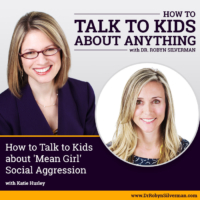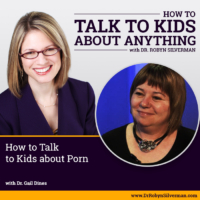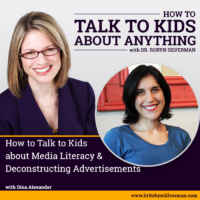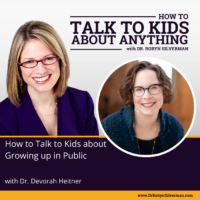Podcast: Play in new window | Download
Subscribe: Apple Podcasts | RSS | More
How to Talk to Kids about Diverse Family Structures
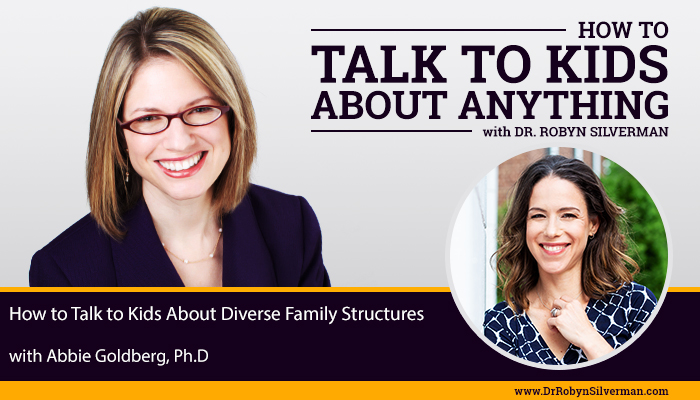
This podcast will focus on the range of different types of families there are—especially families that were built through adoption and families that are headed up by two-dads or two-moms or a range of others who love them (grandparents, single parents). What makes a family? It’s about process not structure—it’s who loves and takes care of you, not their gender or biology! Thank you to Professor Abbie Goldberg, recognized scholar, speaker and author, for all her amazing eye-opening information.
Special guest: Abbie Goldberg, Ph.D
 Let’s talk about family. That word can mean different things to different people. While media outlets—from TV shows to movies to the press are becoming better at highlighting different types of families, The traditional mom-dad-kid family still seems to be the default. Even when watching animated children’s movies where one parent dies before the adventure begins, the implied family structure typically starts as a dad, a mom, and a child.) This sends a message about what is supposedly “normal,” and with children naturally wired to want to belong, perceiving your family as “different” can make children feel “less than.” Let’s aim to change this by being more inclusive in our conversations and explanations of what alternative families look like. We have spoken, in the past, about blended families and some about adoption- but today I’d like to go deeper into adoption as well as other family structures like gay and lesbian parenting with someone who has been studying diversity in families for quite a while, Professor Abbie Goldberg.
Let’s talk about family. That word can mean different things to different people. While media outlets—from TV shows to movies to the press are becoming better at highlighting different types of families, The traditional mom-dad-kid family still seems to be the default. Even when watching animated children’s movies where one parent dies before the adventure begins, the implied family structure typically starts as a dad, a mom, and a child.) This sends a message about what is supposedly “normal,” and with children naturally wired to want to belong, perceiving your family as “different” can make children feel “less than.” Let’s aim to change this by being more inclusive in our conversations and explanations of what alternative families look like. We have spoken, in the past, about blended families and some about adoption- but today I’d like to go deeper into adoption as well as other family structures like gay and lesbian parenting with someone who has been studying diversity in families for quite a while, Professor Abbie Goldberg.
BIO
Abbie E. Goldberg is a Professor in the Department of Psychology at Clark University in Worcester, Massachusetts, where she also currently serves as the Director of Women’s & Gender Studies, and is the current holder of the Jan and Larry Landry Endowed Chair (2020-2023). Dr. Goldberg is an internationally recognized scholar, speaker, and consultant, who is regularly interviewed by media outlets including the New York Times, The Atlantic, the Boston Globe, and New York Magazine. Her research examines diverse families, including LGBTQ-parent families and adoptive-parent families, as well as the experiences of marginalized groups such as trans youth. A central theme of her research is the decentering of any “normal” or “typical” family, sexuality, or gender, to allow room for diverse families, sexualities, and genders. Dr. Goldberg is the author of over 140 peer-reviewed articles, over 25 book chapters, and four books: LGBTQ Family Building: A Guide for Prospective Parents (APA; 2022), Open Adoption & Diverse Families (Oxford; 2020), Gay Dads (NYU Press; 2012), Lesbian and Gay Parents and their Children (APA; 2010). Her research has been cited worldwide and she teaches courses on diversity in contemporary families, research methods with diverse families, human sexuality, the psychology of sexual orientation, gender and crime, and ethics in clinical psychology.
Important Messages:
- Families are really diverse and the research wasn’t keeping up with that fact.
- Why “traditional” family default: nostalgia and holding on to what we believed to be the ideal even if it’s not always the happiest—and even if we’ve seen diverse families that are, indeed happy and healthy. Might not be the most common- but that’s the “ideal” family. See it represented over and over again. Clung to the idea that this is the ideal.
- Assumption- heterosexual couples raising children- not necessarily the most healthy or happy. Need to tease out family structure vs family process. It’s not the structure that’s important but what’s happening within the family that’s most important.
- Most profound adoption statistics from her longitudinal study of 17 years. Open adoption- some amount of contact with birth family. Some weren’t onboard with open adoption- but changed- and got onboard- expansive view of family. Relationships have changed over time.
- Origin stories: Make sure not to lie. Not perfect. At some point, you are going to give a more nuanced rendition. So start with the truth! When parents start, they don’t always tell a story that approximates the truth. Emphasize that all the people involved loved you very much. Placed for adoption because they had very few resources that allowed them to raise you.
- *Put the child at the center of their origin story. “Your safety was the priority.” Empowers the child. They were the center.
- Children who were placed for adoption when their siblings remained can be tough. “Your birth mother couldn’t take care of you at that time.” Be specific around the circumstances. “Couldn’t take care of another child at that time. Really challenging at that time.”
- Broaching an origin story. “We know a lot more about your birth mom than your birth dad. As you get older and as you need it, we will do our best to find out more information.” Let’s say that the birth father is incarcerated. Work with the child’s developmental stage. Only allowing story to become more nuanced. “We don’t know a lot about your birth father.” Then a little older. “We don’t know a lot, but we do have a few details…which are.. and if you’d like to know more, we can try to find out more.” Next, “we now know that your birth father is incarcerated. Would you like to write him a letter?” This may be very positive for a child. Monitor. How are they experiencing it? May need adoption-aware therapist to help with process. By teenager, have all details of origin story that can be relayed.
- When you don’t know the origin story (international adoption, for example, often the case). (1) Validate how painful this is. Adoptive parents take on that information and manage it. (2) New ways to seek out information. Might not be birth parents and home and origin but could be 23 and me, geneology. A way in- access to information about identity. Not the same thing as knowing who your birth parents are- but provides important information. (3) Detectives- find out information about origins. Some have had success.
- Origins- trying access by incorporating traditions, language, visiting place of origin as a family. Fact finding mission. Back to orphanage. Excursion to find information. Cultural emersion and a fact-finding mission.
- Parents need to recognize that they are now part of a multi-cultural, multi-racial, multi-lingual family. This isn’t just their child identity. (sending child off to culture camp). You’ve taken this on as well. Put yourself in situations where YOU are the minority! Parents should realize what their child experiences all the time- being of a different background, phenotypically dissimilar than family members, looking different, being the only person of color in a group- parents owe it to their kids to look for opportunities where they are the ones who look different or feel different whether that’s in another country, or a church, or a neighborhood or a school.
- AHA moment: Goes both ways! Not one sided. Our heritage is part of your heritage and your heritage is part of our heritage! Child’s heritage needs to be integrated and celebrated and combined in order for your child to thrive. Not just part of them—part of the family’s heritage now. Take it on as our responsibility. Transracial adoptees. Parents, ask selves, what would it be like for me to be uncomfortable? Rather than asking my child to adapt to a predominantly white school- what it be like, for me, to live in a primarily black community, if you are white with a black child? Or go to church- where I am one of the minorities and my child is part of the majority? What is going to work for my child? Growth opportunity to get uncomfortable. (This goes with the theory of getting proximate too—when we get proximate, we learn).
- Careful with language- when origin stories contain ugly details. What if the child was abused? (1) Careful not to say “your birth parents were bad people.” Untrue and child internalizes it as part of them- if my birth dad was a bad person, what does it say about me? Boys in particular. Child tends to identify most with same-gender parent. “Birth father is a criminal and is in jail” can be damaging. How is a child going to interpret that and internalize that in terms of what it says about him? (2) Don’t get into personal qualities and the blame game. Instead talk about systems and safety. “Your birth mom really had a hard time.” When we see abuse and neglect, talking about mental illness and poverty. “Your birth parents had a really hard time. They didn’t have the supports they needed to be able to parent you in a way that they wanted to and needed to (and that you needed from them).” Can change as older. “Your birth mother had a diagnosis of X. This means that there were XYZ behaviors and challenges. This made it hard to parent.” Get more specific as time goes on. Consistently remember that whatever you say, these kids can and will internalize the information as part of themselves. You don’t want yourself to be summed up in one label- let’s not do it to others. It’s more nuanced than that.
- Gay and lesbian parenting. Unique struggles. Things have really changed. Increasingly more positive. Wins in terms of family recognition. But depending where you live, the rights of LGBTQ parents and families have been challenged. (Book coming out LGBTQ people who want to become parents). Live in affirming area with LGBTQ families- vs in an area where your child is the only one with LGBTQ parents- matters. Also, how much money you have. Place child in private school if public school better fit. Community that’s more accepting. You get choice if you have money. Other co-challenges- minority plus adoption plus LGBTQ- makes it more challenging. Biggest other challenge is not understanding your family. Children teased “less than”. “You don’t have a dad so you aren’t part of a real family. “My grandparents say…” “Two women can’t get married.”
- If we want to create a more accepting world—what can we say to our kids about diverse families? Less likely to tease. (1) Reemphasize how diverse families are. “That two-dad family is just one of many different kinds of families that exist. Some people have two-dads, some people are raised by grandparent, some have 3 parents (divorced/remarried), some have a single parent.” Help kids to know- that this is part of a spectrum of different types of families. (2) Process vs structure. “Families are defined by who loves you and who you spend time with- not the gender of parents. What makes a family? Do things together, spend time together, in many cases- live together.”
- How do two-dad or two-mom families have kids? “Some families need to count on other people outside of the family to help make a family.” Go deeper into that. Adoption. Sperm donation. Egg donation. Surrogacy. Cory Silverberg- book on how babies are made may include this.
- Kids who were adopted- “I know how I came into this family- but other people
 don’t all come to their families that way—how?” Inverse order of sex talk.
don’t all come to their families that way—how?” Inverse order of sex talk. - Top tip: Want kids to understand- not just that there are a broad range of different families. But also, we don’t know how our kids will grow up! We don’t know if our kids will adopt, if our kids will be gay, or if our kids will decide that they don’t want kids at all. So part of it is saying, “be kind, accept, empathize, be respectful to other families- don’t judge. Part of it is anticipating the range of possibilities that kids have for themselves. We don’t want kids to foreclose any possibilities for themselves (and to be themselves, and to do what makes them happy- not what others think is supposed to happen). So when we reinforce the idea of a particular kind of family that is valid, we are not only shaping how they treat other people, we are shaping what they can imagine for their ow futures and for their own lives.
Notable Quotables:
- “While we know that this is not the dominant family structure as we have divorced families and adoptive families, and two-mom families, single parents and grandparents raising children- we have clung to this ‘nostalgic’ idea that mom-dad-two kids represents the ideal. Ironically, that may be the case even when what’s going on in that ‘ideal’ family isn’t so happy or healthy– and even though we have seen perfectly happy and healthy representations of diverse families all around us.”
- “What happens within families matters more to kids’ development than whether you have a mom and a dad. Are your parents warm and supportive? Do you have people you can count on? Sense of safety? Good relationships? That’s what matters most.”
- Put the child at the center of their origin story. ‘Your safety was the priority.’”
- “There is a way to tell an origin story that is truthful and nuanced—and upbeat, to the extent that it can be.”
- Parents need to recognize that they are now part of a multi-cultural, multi-racial, multi-lingual family. This isn’t just their child identity. You’ve taken this on as well. Put yourself in situations where YOU are the minority! Parents should realize what their child experiences all the time- being of a different background, phenotypically dissimilar than family members, looking different, being the only person of color in a group- parents owe it to their kids to look for opportunities where they are the ones who look different or feel different whether that’s in another country, or a church, or a neighborhood or a school.
- We want kids to understand, not just that there are a broad range of different families, but also, we don’t know how our kids will grow up! We don’t know if our kids will adopt, if our kids will be gay, or if our kids will decide that they don’t want kids at all. So, part of it is saying, ‘be kind, accept, empathize, be respectful to other families- don’t judge.’ Part of it is anticipating the range of possibilities that kids have for themselves. We don’t want kids to foreclose any possibilities for themselves. So, when we reinforce the idea of a particular kind of family that is valid, we are not only shaping how they treat other people, we are shaping what they can imagine for their ow futures and for their own lives.”
Which family structure helps kids thrive the most? @DrRobyn interviews @DrAbbieG on How to #TalktoKids about Anything for the answer
Click To Tweet
Resources:
- AbbieGoldberg.com
- TeachAllFamilies.com (how to create more inclusive learning environments)
Social Media for Dr. Robyn:
- facebook.com/DrRobynSilverman
- twitter.com/DrRobyn
- instagram.com/DrRobynSilverman
- facebook.com/HowToTalkToKidsaboutAnything
The post How to Talk to Kids about Diverse Family Structures with Abbie Goldberg, Ph.D appeared first on drrobynsilverman.com.

